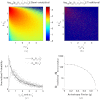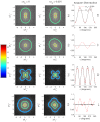Open source software for electric field Monte Carlo simulation of coherent backscattering in biological media containing birefringence
- PMID: 23123973
- PMCID: PMC3487050
- DOI: 10.1117/1.JBO.17.11.115001
Open source software for electric field Monte Carlo simulation of coherent backscattering in biological media containing birefringence
Abstract
ABSTRACT. We present an open source electric field tracking Monte Carlo program to model backscattering in biological media containing birefringence, with computation of the coherent backscattering phenomenon as an example. These simulations enable the modeling of tissue scattering as a statistically homogeneous continuous random media under the Whittle-Matérn model, which includes the Henyey-Greenstein phase function as a special case, or as a composition of discrete spherical scatterers under Mie theory. The calculation of the amplitude scattering matrix for the above two cases as well as the implementation of birefringence using the Jones N-matrix formalism is presented. For ease of operator use and data processing, our simulation incorporates a graphical user interface written in MATLAB to interact with the underlying C code. Additionally, an increase in computational speed is achieved through implementation of message passing interface and the semi-analytical approach. Finally, we provide demonstrations of the results of our simulation for purely scattering media and scattering media containing linear birefringence.
Figures









References
-
- Kuga Y., Ishimaru A., “Retroreflectance from a dense distribution of spherical particles,” J. Opt. Soc. Am. A 1(8), 831–835 (1984).JOAOD610.1364/JOSAA.1.000831 - DOI
-
- Tsang L., Ishimaru A., “Backscattering enhancement of random discrete scatterers,” J. Opt. Soc. Am. A 1(8), 836–839 (1984).JOAOD610.1364/JOSAA.1.000836 - DOI

